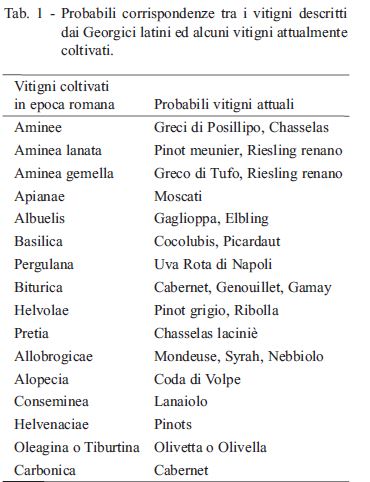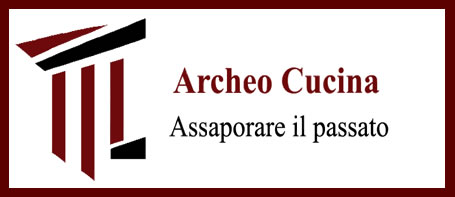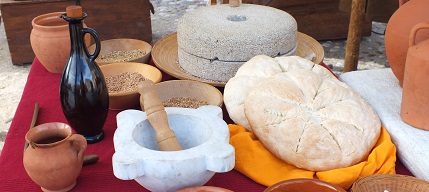I VINI
In Rome traditional wine had nothing to do with the thrill, with the loss of consciousness, ie the visual discernment through suggestion sound. The wine was
food: prepared with measure had to be drunk in moderation, to give greater force to the body healthy, to cure the sick. In its religious significance - does not exist
in ancient Rome human act that has its basis in a higher order
divine - it was offered to Jupiter, protector of human balance and to
a world that then was clearly to be identified only in the order of
Rome. Stages of the preparation of the wine were characterized by rituals and times
chanted the same time of individual, civil and political life of the City.
.
The wine tended the body as well as the farmer "cured" the wine through a fair
balance between its components, because the drink was not natural product, but wise proceeds of a refined technique. And in its religious significance - does not exist in traditional Roma human act that has its basis in a higher divine order - and it was entrusted
offered to Jupiter, protector of balance human and that of a world detectable only in the order of Rome. Obviously the initial phase of the cycle of the wine began with the collection of the fruit, which took place from the end of August, and that led
then vinification in October. This moment was ritually celebrated August 19, a day of public holiday referred to as Vinalia rustic. The calendar date shall also contain a dedication to Venus, which was celebrated the consecration of two temples, one at
the Circus Maximus, the other at the Bosco Libitinese (Fest. 322 L.). Yet the ritual with which you began the harvest had turned to Jupiter after the priest had taken the guts of a lamb, you had the extirpation of the first cluster, and then offering to the god of the innards.
This ritual, described by Varro, had a clear purpose, as highlighted
the same author: "pro tempestatibus leniendis" (Varr. de l. L. 6, 16), namely to prevent rain and wind could ruin the harvest. We reach the second phase of the cycle, one in which the fruit
is transformed into the drink. Activities that took place during the month of October, with the ritualization fixed on 11, indicated that the calendars as a day of Medritinalia. Significantly since the calendar Amiternino indicate this day as feriae Iovi, to highlight that even at this stage of production was placed under the protection
the supreme god. The term "Meditrinalia" should come from the noun "Meditrina", indicated by Dumézil as the place used for the production of the drink. What was going through an operation of mixing, so the juice of the grape juice was added to some
amount of high-proof wine aged in order. Varro writes "Meditrinalia to medendo ', thereby deriving the term from the verb medeor, meaning" cure ". The must, because turning into wine, must be "cured", or treated with strong wine, so
reach that state which makes it suitable for human consumption: not too strong, as to be intoxicating, not lack the strength which makes it also a drug, in fact able to cure those who usacon moderation.
Returning to the relationship with Jupiter, we note that even in this case the god is placed to protect a form of balance, as the wine of those who consume it: he must with its moderation safeguard the salus citizen, that is to coincide with the salus (salvation) of
State.
The rise of the Roman Empire led to an increase in technology and knowledge of the techniques of wine production and it is through the Romans that spread throughout the empire. The Roman influence had a profound effect on the stories of the major wine regions, then in Italy, France, Germany, Portugal and Spain. The Romans introduced the right to land ownership, securing the borders through the cadastre and land division. Pliny testifies to the existence of three types of wine of this wine: sweet, subtle and austere. Among the 30 wines mentioned in Roman times, two deserve explanation: Cecubo and Falerno. Cecubo (or Caecubum), made with grapes from the variety Cecuba and described by Strabo as "excellent and substantial," was destined to final toast at banquets. The greek physician Galen defines it thus: "pleasant, good tone, strong food substance, good for intelligence and for the stomach." At the time of Pliny is almost abandoned by growers because it faces competition of wines of Marseille, which for their smoky taste conquered the rich market of Rome. The product is Falernian nell'Ager Falernus between Calenus and Sinuessa in Campania, at Mount Massico. The terms used to describe it, especially from Horace, are Severum (ie dry), ardens (fiery), fortis (strong). It was yellow and improved with long aging. At 15 he was perfect and became as said Martial, fuscus, ie brown. it is said that it needed at least 10 years to refine, reaching its peak in quality between 15 and 20 years, sometimes even more. The legendary longevity of this wine has witness in Satyricon where Trimalcione offers Falernian 100 years. The appearance of the bitter taste was mitigated by adding honey penthouse, also in a symbolic meaning, to join the force Latin to Greek sweetness. Such was his importance that was offered by Caesar to the people to celebrate his military triumphs in Gaul and Spain. Up to 800 in Germany was synonymous with the wine of higher quality in Europe. Falerno was one of the legendary wines of antiquity and was certainly the first denomination of origin of the world. The types were the most prized and Falerno Massico (Campania), Cecubo, the Volturno, the 'Albano and Sabino (Lazio) and the Setino; the poorer were the Veietano (like all the wines of Etruria was considered of poor quality), the Vatican and to Marseille (wines of Gaul Narbonne were smoked and often counterfeited); there were also some resinous wines, but considered to be of poor quality, since the resin was added to wines poorer so that it retained longer. On amphorae used for transportation was etched in a label (pittacium) the origin and date of production to protect the buyer, even if already at that time there were cases of adulteration; for example in a recipe of Apicius are taught to turn the red wine in white. The flavored wines are listed under the name of Aromatites, of Mirris, one of the most appreciated. It was in fact the habit of making an aromatic wine, prepared approximately as fragrances, first with myrrh then reed, cane, cinnamon, saffron and palm. The Gustaticiumè an aperitif wine that you drink on an empty stomach before the meal, was a wine to which was added honey. Finally they were rich in medicinal wines, mingled wine and honey, and the product was called Mulsum. The Passumera a wine made from dried grapes but which served for the sick. Some families of Pompeii had specialized in viticulture and were aged in the cellars of the amphorae mulsum.I aged wines (those who had spent the summer after the date of production) were of great value on the tables of the rich Romans, who flaunted them in their banquets. There were also surrogates of wine as the lora, obtained by fermentation of grape marc with water immediately after harvest and posca, formed by water and sour wine (acetum) .In 37. C. Varro wrote in his Res rusticae that Falernum increased greatly in value when ripened and Pliny wrote that the famous Falernum Opimianum (had been collected in the centuries of Lucius Opimius) of 121 a. C. was served at a banquet in the year 60. C. in honor of Julius Caesar, on the occasion of his conquests in Spain. Even Caligula loved Falernum Opimianum aged for many decades. and Petronius Arbiter in dinner Trimalcione does serve as the most important wine Falernum Opimianum aged one hundred years. The Falernum was thus the most famous wine produced in ancient Rome, considered a first wine "grand cru" or worship in his time, sold all over the world, his reputation has been immense. Amphorae Falernum were sold in Britain, Gaul, Hispania, Carthage and Alexandria.
It was the wine offered by Cleopatra to Caesar after the victory. Its origin is uncertain, but it appears on the slopes of Mount Massico.
The famous physician Galen wrote, in 180 d. C., to doubt that all Falernum sale in Rome were original, so even then there was a risk of infringement of the doc!
In the ruins of ancient Pompeii found a price list on the wall of a thermopolium declaring: "For an axis can drink wine for two axes you can drink the best and for four Falernian can drink."
FALERNO OF THE MASSICO: When you think about the origins of viticulture not only of Campania, but the whole of Italy, reference should be made to Agro Falerno, the northern area of the Campania region on the border with Lazio, which the Romans had just called Ager Falernus . It is a hilly occupied largely by the extinct volcano of Roccamonfina and Mount Massico. Here was born the prince of wines, Falerno, that Virgil (Georg. II, 96) was unrivaled and that Strabo (V, 4.3) gave fame to the entire wine production of Campania. Pliny (Nat. Hist. XIV, 61-66) classifies it in 2nd place for quality and reputation among all Italian wines at the time of Augustus. Falerno was required so that its production could not keep up with demand: that was how it was frequently falsified, as we are informed Galen (XIV, 77). Frequent references are also in the works of Martial, Catullus and Horace.
From the evidence of these authors deduce that Falerno was produced in three different locations, but with only one variety. It seems that the producers were more than 150. They were obtained by three qualities: the austerum, the dulce and the small intestine.
Is described as a dense wine (severus), strong (fortis), burning (ardens) and color full-bodied (nigro et Fusco). As was the case for all wines of the time, also the Falernian was softened in the flavor with the addition of honey or water.
Falerno was also popular with most prominent ancient Rome. Caesar offered it to the people on the occasion of his triumphs. In Satyricon is even talk of a Falernian 100 year old and is not the only example that demonstrates the legendary longevity of this wine.
And a legend was in danger of becoming the Falernian, because of phylloxera, a pest animal that at the end of the last century has destroyed most of these vineyards. Thanks to the loving recovery of the few survivors, today you can still enjoy this wine in all its fragrance.
THE GREEK TUFF: In antiquity the name of "Greek" and was given to many grapes, even outside of Campania. Pliny, for example, remember a Sicilian variety. This custom was continued even during the Middle Ages when several wines were mistakenly addressed as "Greeks".
The "Greek di Tufo" is a very specific variety that has its area of orgine in the territory north of Avellino where stands the town of Tufo. Its origin dates back to the Romans certainly and perhaps even in times immemorial. Columella called the vine "Aminea twin" as produced bunches double. Pliny says that the vine gave "a wine slightly hard, but that is very well kept improving with age."
Cato provides further differentiation in "Aminea minor", intended for the production of wine and grown in fertile and well exposed, and that "maior", whose grapes were instead more suitable for direct consumption.


|

